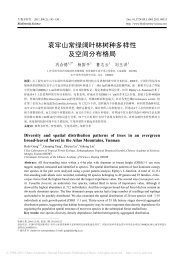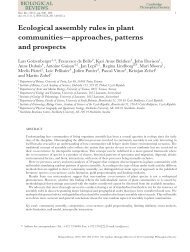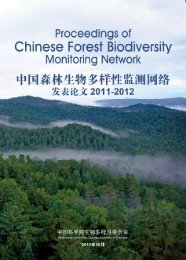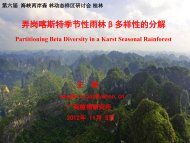the maintenance of species-richness in plant communities
the maintenance of species-richness in plant communities
the maintenance of species-richness in plant communities
You also want an ePaper? Increase the reach of your titles
YUMPU automatically turns print PDFs into web optimized ePapers that Google loves.
Ma<strong>in</strong>tenance <strong>of</strong> <strong>species</strong>-<strong>richness</strong> <strong>in</strong> <strong>plant</strong> <strong>communities</strong> 117<br />
example given above to illustrate <strong>the</strong> reality <strong>of</strong> differences <strong>in</strong> requirements for regeneration<br />
concerned trees. The examples that we now f<strong>in</strong>d easiest to comprehend and most<br />
conv<strong>in</strong>c<strong>in</strong>g were also historically <strong>the</strong> first to be appreciated, It was <strong>the</strong> foresters who<br />
first realized <strong>the</strong> importance <strong>of</strong> differences <strong>in</strong> regeneration-requirements. Heyer (1852)<br />
seems to have been <strong>the</strong> first to publish an explicit account <strong>of</strong> differences <strong>in</strong> ‘tolerance’<br />
<strong>of</strong> tree seedl<strong>in</strong>gs; as Tourney & Korstian (1937) po<strong>in</strong>ted out, <strong>the</strong> orig<strong>in</strong>al emphasis<br />
was on degrees <strong>of</strong> tolerance <strong>of</strong> shade, but <strong>in</strong> <strong>the</strong> present century differences <strong>in</strong> <strong>the</strong><br />
ability to tolerate root competition have been <strong>in</strong>creas<strong>in</strong>gly emphasized. In <strong>the</strong> 1950s<br />
<strong>the</strong> importance <strong>of</strong> differences between <strong>species</strong> at all <strong>the</strong> stages <strong>in</strong> <strong>the</strong> regeneration<br />
cycle came to be appreciated particularly <strong>in</strong> relation to tropical ra<strong>in</strong>-forest and tropical<br />
deciduous forest (Jones, 1955-6; Hewetson, 1956; Steenis, 1956). More recently <strong>the</strong><br />
question has been discussed and illustrated for tropical ra<strong>in</strong>-forest by Budowski (1965),<br />
Poore (1967,1968), Ashton (1969), Richards (1969), Rollet (1969), Janzen (1970) and<br />
Whitmore (1974, 1975) and for a subtropical ra<strong>in</strong>-forest by Webb,Tracey & Williams<br />
(1972). A particular idea that attracted much attention at <strong>the</strong> time was that <strong>of</strong> Aubreville<br />
(1938), who suggested that any one tree <strong>species</strong> never regenerated under itself;<br />
later workers, however, have shown that this generalization was not true (Jones, 1955-6;<br />
Foggie, 1960; Schulz, 1960; Rollet, 1969). Most recently emphasis among writers<br />
concerned with <strong>species</strong>-<strong>richness</strong> <strong>in</strong> tropical forests has been concentrated on differences<br />
<strong>in</strong> flower<strong>in</strong>g phenology (Gentry, 1974, 1976; Stiles, 1975). There seems to have been<br />
much less explicit discussion <strong>of</strong> <strong>ma<strong>in</strong>tenance</strong> <strong>of</strong> <strong>species</strong>-<strong>richness</strong> <strong>in</strong> temperate forests,<br />
although more <strong>in</strong>terest has been shown <strong>in</strong> <strong>the</strong> last two years - see, for example, <strong>the</strong><br />
papers <strong>of</strong> Forcier (1975), Horn (1975), Pigott (1975) and Ash & Barkham (1976).<br />
Many earlier studies <strong>of</strong> regeneration showed implicitly that <strong>the</strong> same pr<strong>in</strong>ciples<br />
apply as <strong>in</strong> tropical forests, e.g. those <strong>of</strong> Watt (1934, 1947), Graham (1941), Jones<br />
(1945), Bray (1956), Curtis (1959), Franklyn & Dyrness (1969), Auclair & Cottam<br />
(1971), Williamson (1975), Sprugel (1976) and <strong>of</strong> various Cont<strong>in</strong>ental authors as<br />
summarized by Ellenberg (1963). Whittaker (1969) mentioned <strong>the</strong> ‘successional<br />
niche’ and appeared to refer to <strong>the</strong> parts played by different <strong>species</strong> <strong>in</strong> <strong>the</strong> natural<br />
regeneration <strong>of</strong> eastern deciduous forest <strong>in</strong> <strong>the</strong> U.S.A. after sheet destruction by fire;<br />
<strong>in</strong> a later paper (Whittaker, 1972, pp. 239-40) he seemed to broaden his concept <strong>of</strong> <strong>the</strong><br />
successional niche but he considered it only briefly. Loucks (1970), <strong>in</strong> a general treatment<br />
<strong>of</strong> diversity, also started from a forestry background; he emphasized <strong>the</strong> importance<br />
<strong>of</strong> <strong>species</strong> react<strong>in</strong>g differently to periodic perturbations, notably fires and cyclones.<br />
In treatments generally detached from <strong>the</strong> discussion <strong>of</strong> particular <strong>communities</strong><br />
Skellam (1951) has shown <strong>the</strong> importance <strong>of</strong> differences <strong>in</strong> dispersability, and Harper<br />
and colleagues have repeatedly emphasized <strong>the</strong> potential importance <strong>of</strong> different<br />
requirements for germ<strong>in</strong>ation and establishment, and <strong>the</strong> nature <strong>of</strong> ‘safe sites’ for<br />
particular <strong>species</strong> (Harper, 1961, 1965 ; Harper et al. 1961 ; Harper, Williams & Sagar,<br />
1965; Cavers & Harper, 1967; Sheldon, 1974).<br />
Most recent discussions on diversity <strong>in</strong> grasslands have been notable for a failure to<br />
appreciate <strong>the</strong> relevance <strong>of</strong> regeneration processes - see, for example, <strong>the</strong> articles <strong>of</strong><br />
McNaughton (1967, 1968b), Grime (1937a, b) and Newman (1973). They have<br />
concentrated on <strong>the</strong> negative correlation <strong>of</strong>ten found between <strong>species</strong>-<strong>richness</strong> and
















